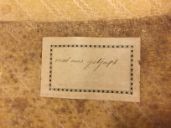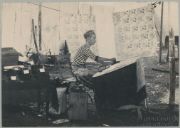“Getjapt” with wax
The first cloth has been decorated with a pattern made from wax, possibly beeswax in combination with paraffin and resin. On a paper label on the backside it says “Met was getjapt” (stamped with wax). “Getjapt”, which translates to ‘stamped’, refers to the word tjap. A tjap, nowadays spelled Cap, was a copper stamp that was made on the island Java in Indonesia. With a Cap you can easily print a repeating pattern on a cloth with wax. This innovative technique was a very welcome invention, as it could serve as a replacement of or an addition to the more time consuming Batik Tulis, the ‘hand-written’ batik on which drawings on the fabric are made with a “canting”, a copper wax pen.
The Cap was gaining in popularity when the first imitation batiks came on the market around 1850. The Batik Tulis could not compete with the machine-made imitations from Europe, like the ones from the Leidsche Katoenmaatschappij (LKM), for example, but Batik Cap could. That makes it all the more interesting that LKM in particular had this collection of cloths.


